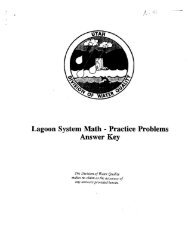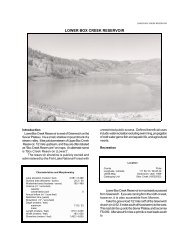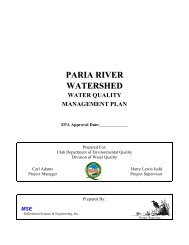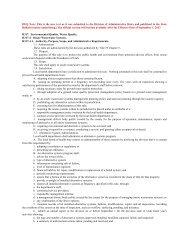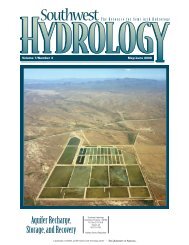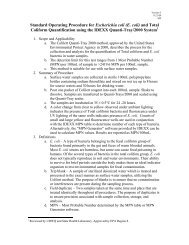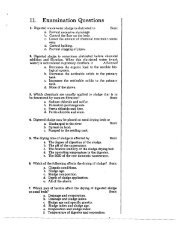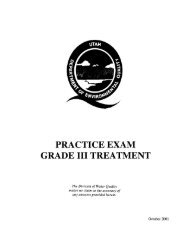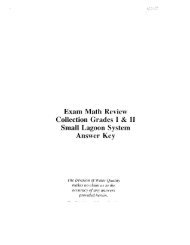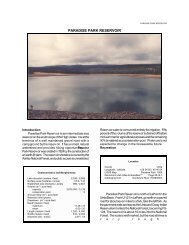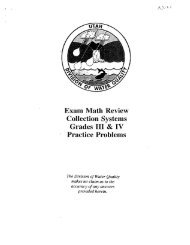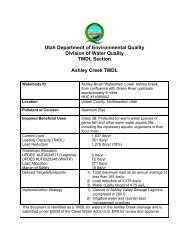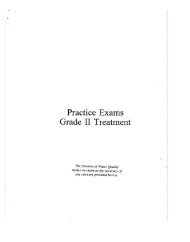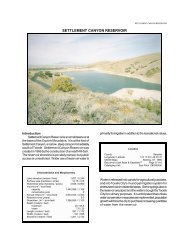Lagoons and Ponds - Division of Water Quality
Lagoons and Ponds - Division of Water Quality
Lagoons and Ponds - Division of Water Quality
Create successful ePaper yourself
Turn your PDF publications into a flip-book with our unique Google optimized e-Paper software.
8. '. Examination Questions1. Cattails, rushes. <strong>and</strong> grass at the water's edge should becut or killed in order to discourageBasica. High water losses.b. Unsightly conditions.c. Mosquito breeding.d. Interference with wind movement.2. The embankment <strong>of</strong> wastewater stabilization ponds shouldbe covered withBasica. Grass with deep penetrating roots.b. Grass with shallow roots.c. Weeds.3. Important operation <strong>and</strong> maintenance aspects <strong>of</strong> wastestabilization ponds include control <strong>of</strong>Basica. Diffuser.b. Waste gas burner.c. Protozoa.d. Drying beds.e. Weeds <strong>and</strong> insects.4. Scum rafts in a waste pond Basica. Are desirable because they will help algaegrowth.b. Are undesirable because they will attract birds.c. Are desirable because they will prevent mosquitobreeding.d. Are desirable because they will prevent growth<strong>of</strong> tules.e. Are undesirable because they will cause odor<strong>and</strong> reduce sunlight penetration.5. Surface agitation in a lagoon is a recommended method<strong>of</strong> controllingBasica. Suspended algae.b. Blue-green algae.c. Duckweed.d. Cattails.6. The highest DO content may be expected at Basica.. 3 a.m.b. 3 p.m.c. 7 a.m.d. 9 a.m.'1. The most favorable time for biological activity in wastewaterstabilization ponds is inBasica. Winter.b. Fall.c. Summer.d. Spring.8. A long hot period may cause overloading <strong>of</strong> a lagoon bya. Killing bacteria. Advancedb. Lowering the DO saturation level.c. Causing excessive algae.d. Lowering the water level.
9. When the population <strong>of</strong> algae <strong>and</strong> its activities increase.the pH <strong>of</strong> a waste stabilization pond usually Advanceda. Remains at 4.0.b. Remains at 7.0.c. Goes up.d. Goes down.e. None <strong>of</strong> the above.10. The primary cell <strong>of</strong> a wastewater stabilization pondAdvanceda. Should retain solids <strong>and</strong> allow the liquid toseep into the ground.b. Is intended as an open lagoon for anaerobictreatment.c. Is a biological wastewater treatment facility.d. Provides the same type <strong>of</strong> treatment as a primarytreatment plant.11. Emergent vegetation on the pond bottom. such as cattails.may best be controlled byAdvanceda. Pulling.b. Spraying.c. Keeping the water depth greater than 2 ft.d. Alternating ponds so as to let the bottom dryout.12. In spraying to control rushes <strong>and</strong> cattails. chemicalsshould be mixed inAdvanceda. Oil emulsion.b. Plain water.c. Soap or detergent solution.d. Kerosene.13. In the design <strong>and</strong> operation <strong>of</strong> an oxidation pond. which<strong>of</strong> these factors is important?Basica. Surface area.b. Depth <strong>and</strong> shape.c. Control <strong>of</strong> weeds <strong>and</strong> vegetation around theedges to prevent mosquito breeding.d. Inlets <strong>and</strong> outlets.e. All <strong>of</strong> these.14. Depth is an important factor to be considered in the design<strong>and</strong> operation <strong>of</strong> an oxidation pond. The 3-ft depthpresently recommended has been selected because Basica. Common water plants grow best at the 3-ftdepth.b. Common water plants are discouraged at thisdepth. <strong>and</strong> a reasonable depth <strong>of</strong> sunlight penetrationis obtained.c. Vertical circulation is obtained at greaterdepths. <strong>and</strong> horizontal currents prevail at shallowerdepths. which seriously interferes withperformance.a
15. An aerated cell is followed by or---_(pick two.)Basica. a st<strong>and</strong>ard cell <strong>and</strong> polishing ponds.b. a trickling filter.c. a clarifier <strong>and</strong> chlorination.d. chlorination <strong>of</strong> effluent.16. Performance <strong>of</strong> waste stabilization ponds is a function <strong>of</strong>a. Type <strong>and</strong> quantity <strong>of</strong> virus. Advancedb. pH.c. Type <strong>of</strong> soil.d. Short circuiting.e. Surface area.17. The gas produced in largest volume as a result <strong>of</strong> theproper digestion <strong>of</strong> wastewater solids in a lagoon isa. Hydrogen sulfide. Advancedb. Carbon dioxide.c. Methane.d. Nitrogen.e. Hydrogen.18. The basis <strong>of</strong> operation <strong>of</strong> a wastewater lagoon for secondarytreatment isBasica. Aerobic organisms <strong>and</strong> algae.b. Anaerobic organisms <strong>and</strong> chlorophyll.c. Saprophytic bacteria <strong>and</strong> flukes.d. Paramecia <strong>and</strong> amoebae.19. Biological activity within a lagoon is carried on by Basica. Aerobic bacteria.b. Anaerobic bacteria.c. Algae.d. All <strong>of</strong> the above.20. In a stabilization pond. oxygen for the aerobic bacteriacomes from a form <strong>of</strong> plant life. This form <strong>of</strong> plant life iscaBedBasica. Bacteria.b. Grass.c. Reeds.d. Algae.21. Which <strong>of</strong> the following produce the most desirable resultsin an oxidation pond?Advanceda. Bacteria.b. Algae.c. Vegetation.d. Chemicals.e. Chlorination.22. Hydrogen sulfide is ordinarily not a problem in properlydesigned <strong>and</strong> operated waste stabilization ponds becausea. It is in very low concentration. Basicb. It is assimilated by algae.c. It is without any odor.d. It dissociates into hydrogen ions <strong>and</strong> metallicsalt at low pH.e. It dissociates into hydrogen ions <strong>and</strong> hydrosulfideions at high pH.
23. The most common cause <strong>of</strong> odor from waste stabilizationponds isBasica. Methane.b. Carbon dioxide.c. Hydrogen sulfide.d. Nitrogen dioxide.e. Sulfur dioxide.24. Select the chemical that may be used in an attempt tocorrect septic conditions in a new oxidation pond. Advanceda. Calcium sulfate.b. Sodium chloride.c. Hydrogen sulfide.d. Sodium nitrate.e. Sulfuric acid.25. Odors from waste stabilization ponds are usually causedbyAdvanceda. High nitrate concentration in the raw wastewater.b. Shallow depth <strong>of</strong> the pond.c. Algae growth.d. High SS in the raw wastewater.e. Overloading <strong>of</strong> the pond.26. Facultative ponds are Basica. Faulty operating ponds.b. Completely aerobic.c. Aerobic on the top <strong>and</strong> anaerobic at the bottom.d. Very shallow ponds.e. Mechanically aerated ponds.•
SECTION 8 -<strong>Lagoons</strong> <strong>and</strong> <strong>Ponds</strong>l. C 14. b2. ,6 15. a & c3. e 16. b4. e 17. b5. .K b 18. a6. b 19. d7 . c 20. d8. b 2l. b9. c, d & e 22. a10. d 23. c1I. b & c 24. d12. b 25. e.13. e 26 . c



